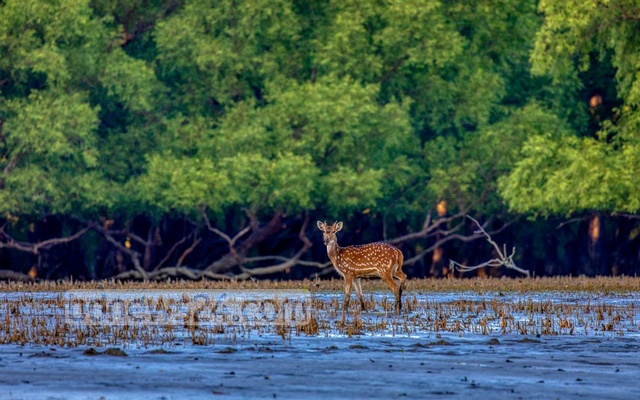Where did all the deer in Katka wildlife sanctuary go?

Dhaka, 7 January, 2020: Herds of spotted deer have flocked to the Kokilmoni Forest in the Sharonkhola Range of the Sundarbans during the eight-month ban on visitors amid the coronavirus pandemic. But the scene was quite different in the Katka wildlife sanctuary, which typically boasts a much larger deer population.
-

Spotted deer are the second-biggest attraction for tourists in the Sundarbans after the Royal Bengal Tiger. While it is rare to catch a glimpse of the big cats, deer can be found everywhere in the world's biggest mangrove forest. The Sundarbans is home to an estimated 150,000 spotted deer.
-

Deer are easily visible in the Katka wildlife sanctuary of East Sundarbans' Sharonkhola Range. During low tides, herds of deer, wild boars and groups of monkeys come to the sanctuary looking for food, attracting large numbers of tourists. While more deer were expected to come to the sanctuary, as the coronavirus epidemic keeps tourists away, that has not been the case so far. Only one spotted deer was seen in the Kewra forest near the Katka office in two days.
-

Only a few seeminlgy nervous spotted deer could be seen from afar at the end of the trail of Katka wildlife sanctuary. Usually, the tourists can get quite close to the herds for a good look at the deer.
-

A large number of deer were seen near Tiger Hill in the Katka wildlife sanctuary during low tide in January. But in November, the number has drastically waned.
-

Herds of deer usually graze under the watchtower in Katka Wildlife Sanctuary every morning and evening. This time, only a handful of deer were seen near the watchtower.
-

Prof Monirul H Khan of Jahangirnagar University's Zoology Department points to two reasons for the dearth of deer in the area, namely, poaching and diseases. The authorities would easily know if the deer population had shrunk due to diseases. Therefore, it must be the poachers that are keeping the deer away, Prof Monirul believes.
-

Poachers can easily enter the Sundarbans through different parts of Barguna, Baleshwer and the Bay of Bengal. Poachers are taking the opportunity to hunt deer stemming from the lack of tourists in the Sundarbans amid the coronavirus pandemic, according to Prof Monirul.
-

The government made the Sundarbans off-limits to tourists and visitors for eight months in a bid to prevent the spread of the coronavirus. Two teams of wildlife photographers visited Katka Wildlife Sanctuary on Nov 1, the day the lockdown was lifted. At least 15 photographers stayed in the sanctuary for two days but could hardly find any deer.
-

Wildlife photographer Faridi Numan went to Katka Sanctuary before the lockdown was imposed and saw hundreds of deer. He was worried to see an almost deer-free Katka in the beginning of November. The deer in Katka were quite used to being around tourists and they came quite near them, he said. But this time, only a few deer were seen and those were very fearful of people.
-

“Many deer are here. They fled upon seeing people,” said a forest security personnel, choosing to remain anonymous, when asked about the drop in the number of deer.
-

Unlike the Katka sanctuary, herds of deer were seen at the Kokilmoni Forest in the Sharonkhola Range.
-

A group of deer graze beside a canal in Kokilmoni while curiously observing the tourists.
-

This male deer in Kokilmoni forest wandered near the people visiting the forest.
-

A saltwater crocodile sunbathes near a deer at Kokilmoni Forest in the Sharonkhola Range of the Sundarbans.

-
The usual number of deer were found in the Tambulbunia area of Chandpai range in east Sundarbans. They were peeking through the dense forest to see the tourists who roaming the area.
-

A group of spotted deer stand in the middle of the trail in the Harbaria eco-tourism centre in Chandpai range, East Sundarbans. The wildlife population in this part of the Sundarbans increased during the coronavirus lockdown.

